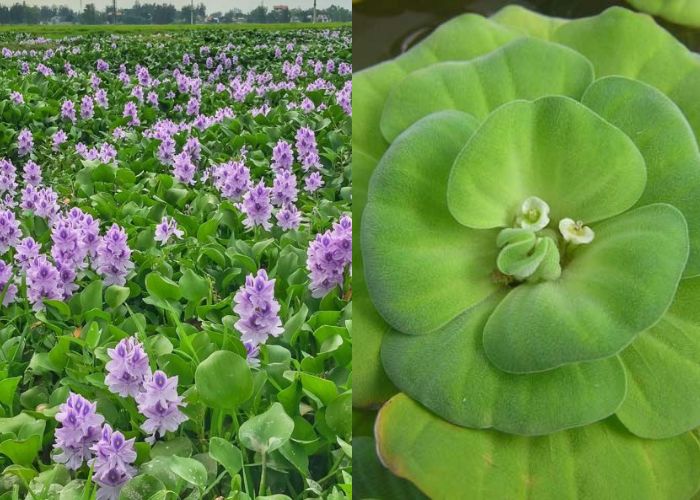Kết quả 1 đến 1 của 1
-
10-23-2023, 04:04 PM #1
 Silver member
Silver member
- Ngày tham gia
- Jul 2023
- Bài viết
- 150
Comparing Water Lettuce and Water Hyacinth: Aquatic Plants in Freshwater Ecosystems
Water lettuce vs water hyacinth
Water lettuce vs water hyacinth: Water lettuce (Pistia stratiotes) and water hyacinth (Eichhornia crassipes) are both aquatic plants that are often found in freshwater bodies such as lakes, ponds, and slow-moving rivers.
While they may appear similar in some ways, they are distinct species with unique characteristics, benefits, and drawbacks. Here's a comparison between water lettuce and water hyacinth:
Appearance:- Water Lettuce: Water lettuce forms rosette-like clusters of light green, floating leaves. These leaves are covered with fine hairs, giving them a fuzzy texture. The plant is relatively flat and has long roots that dangle beneath the water's surface.
- Water Hyacinth: Water hyacinth has thicker, glossy leaves that are usually dark green with a purple hue. Its leaves are more upright, and it produces a distinctive flower spike that rises above the water's surface. The plant has bulbous, spongy stalks that help it stay buoyant.
Reproduction:- Water Lettuce: Water lettuce primarily reproduces asexually through daughter plants that develop as small rosettes. These daughter plants break off from the parent and float independently.
- Water Hyacinth: Water hyacinth can reproduce both sexually and asexually. It produces attractive lavender to violet flowers that can produce seeds when fertilized. It can also produce daughter plants from runners or side shoots.
Invasive Potential:- Water Lettuce: While water lettuce can be invasive under certain conditions, it is generally considered less invasive than water hyacinth. It can form dense mats on the water's surface, which can block sunlight and oxygen, negatively affecting aquatic ecosystems.
- Water Hyacinth: Water hyacinth is notorious for its invasive nature. It can reproduce rapidly and form thick mats that cover water bodies, blocking light and oxygen, which can be detrimental to native plant and animal species.
Ecological Impact:- Water Lettuce: Dense mats of water lettuce can impact aquatic ecosystems by shading out native plants, potentially causing oxygen depletion and altering water chemistry.
- Water Hyacinth: Water hyacinth is known to have a more severe impact on aquatic ecosystems due to its rapid growth, dense mats, and ability to alter water flow and chemistry. It can negatively affect fish populations, water quality, and navigation.
Control and Management:- Both water lettuce and water hyacinth can be challenging to control once they become invasive. Control methods include manual removal, herbicides, and biological control using natural predators and pathogens.

In summary, while water lettuce and water hyacinth share some similarities as floating aquatic plants, they differ in their appearance, reproductive strategies, invasive potential, and ecological impact. Water hyacinth is generally considered more invasive and ecologically disruptive than water lettuce, which has led to more significant efforts to manage and control it in many regions.View more random threads:
- Những thiết kế kệ tivi phòng khách đa năng có thể giữ đồ
- Cổng nhôm đúc đẹp Hải Phòng dành cho biệt thự
- Khả năng làm cho lạnh nhanh chóng của điều hòa gree
- Nội thất shop và các yếu tố phong thủy cho người mệnh Mộc
- 28 lÍ do lÀm trẦn thẠch cao phÒng ngỦ .
- Bamboo Bliss: Crafting an Eco-Friendly Birdhouse for Feathered Friends
- Thiết kế nội thất căn hộ SIÊU ĐẸP/ hoikientruc.com
- Biệt Thự Hiện Đại Thiết Kế Ban Công Đẹp Bằng 4 Cách
- Tìm kiếm loại thảm trải sàn phù hợp với nhà bạn - Nội Thất Go Home
- Sofa vải bố giá rẻ mang vẻ đẹp đến mọi không gian
Các Chủ đề tương tự
-
Comparing water hyacinth vs seagrass - pros and cons
Bởi Thanhcongcraft trong diễn đàn Nội Ngoại ThấtTrả lời: 0Bài viết cuối: 10-18-2023, 04:16 PM -
Nature's Elegance: Water Hyacinth Handbags
Bởi Thanhcongcraft trong diễn đàn Nội Ngoại ThấtTrả lời: 0Bài viết cuối: 10-04-2023, 03:05 PM -
What can water hyacinth be used for?
Bởi Thanhcongcraft trong diễn đàn Nội Ngoại ThấtTrả lời: 0Bài viết cuối: 09-26-2023, 03:24 PM -
Water Hyacinth Basket With Lid
Bởi Thanhcongcraft trong diễn đàn Nội Ngoại ThấtTrả lời: 0Bài viết cuối: 08-22-2023, 02:04 PM -
Natural Elegance: The Round Water Hyacinth Basket
Bởi Thanhcongcraft trong diễn đàn Nội Ngoại ThấtTrả lời: 0Bài viết cuối: 07-27-2023, 02:55 PM


 Trả lời kèm Trích dẫn
Trả lời kèm Trích dẫn





Score Points in Style with the...
Hôm qua, 05:12 PM in Nội Ngoại Thất